Mythical Waters: Trevi Fountain's Enchanting Legends
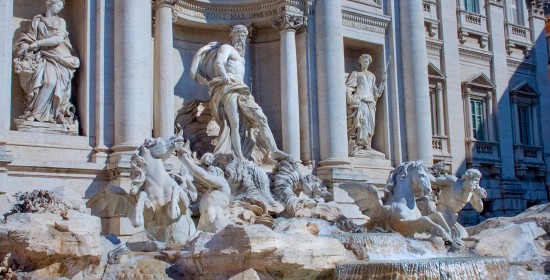
Welcome to Stefano Rome Tours, Rome's leading tour company for private Rome tours, private Civitavecchia Shore Excursions and long-distance transfers in Italy. Trevi Fountain, a mesmerizing masterpiece located in the heart of Rome, has captivated the imaginations of visitors for centuries, not only for its stunning beauty but also for the rich tapestry of myths and legends that surround it.
The majestic 18th-century masterpiece located in Rome's Trevi district stands as a testament to architectural brilliance and historical significance. Designed by Nicola Salvi and completed by Giuseppe Pannini in 1762, the fountain is an imposing Baroque structure, standing 26.3 meters high and 49.15 meters wide, making it the largest of its kind in Rome and one of the most renowned globally.
The fountain marks the endpoint of the revived Aqua Virgo aqueduct. The name "Trevi" derives from the Latin "trivium", signifying the intersection of three streets — Via De' Crocicchi, Via Poli, and Via Delle Muratte. Despite the aqueduct's neglect during the sixth century, the Virgin Water Aqueduct still transports water to the Trevi Fountain, collecting it 10 km from the Italian capital.
Salvi passed away in 1751, leaving the work incomplete, but a team of sculptors, including Pietro Bracci, Filippo della Valle, Giovanni Grossi, and Andrea Bergondi, ensured its magnificent completion in 1762. The Trevi Fountain, predominantly crafted from Travertine stone quarried near Tivoli, remains an iconic symbol of Rome's cultural and artistic heritage, attracting visitors worldwide with its grandeur and the enduring allure of making wishes by tossing coins into its waters.
Join us as we embark on a journey through time, delving into the captivating stories and ancient beliefs that have made Trevi Fountain an enduring symbol of magic and wonder.
Trevi Fountain's Myths and Legends

1. Legend of the Aqua Virgo Aqueduct
The Aqua Virgo aqueduct, known today as Acqua Vergine, derives its name from the Latin term "Aqua Virgo", meaning "Virgin Water." According to popular belief, this appellation originates from a captivating legend surrounding the aqueduct's discovery.
According to the legend, during the construction of the Aqua Virgo aqueduct, a group of Roman soldiers encountered a young maiden (virgin) near the location of the spring. The maiden, with her pure and innocent nature, guided the soldiers to the hidden source of water. In gratitude for her assistance, the aqueduct was named "Aqua Virgo" in her honor.
While the legend suggests a connection to a young maiden, it is more likely that the term "virgo" in Aqua Virgo refers to the purity of the water itself. The Aqua Virgo aqueduct was renowned for providing Rome with clean and fresh water, known for its high quality and taste. The name may have been a symbolic representation of the pristine nature of this particular water source.

2. The Legend of the Virgin
There is another fascinating legend of a virgin tale associated with the Trevi Fountain. It is said that during the construction of the fountain, a young girl led the workers to a hidden spring, revealing the source of water that would flow through the fountain.
As a tribute to her, a statue of the Virgin Mary was placed atop the central niche of the fountain, commemorating her role in the founding of Trevi Fountain and representing the eternal connection between water and life.
3. The Trevi Fountain sea god is Greek, not Roman!
What's truly astonishing about the Trevi Fountain's centerpiece is that it's not Roman, but Greek! Who would have thought? Meet the majestic Greek sea God, Oceanus, proudly standing at the heart of this iconic Roman fountain.
Unlike Neptune, who might have wielded a trident and played with dolphins, Oceanus commands a unique presence, flanked by graceful sea horses and Tritons—those fascinating half-men, half-mermen figures.

Carved with pristine Carrara marble, Neptune's grand portrayal captures the attention of all who behold him. His very essence embodies the might and dominance of the sea, symbolizing Rome's maritime prowess and prosperity throughout history. It's a breathtaking sight to witness!
But that's not all – Nicola Salvi, the brilliant architect behind this masterpiece, ingeniously used these captivating symbols to craft an enthralling essay on water. Look closely, and you'll find that every element has a story to tell. The Triton on the left, struggling with a restless horse, perfectly portrays the tempestuous nature of rough seas. On the other hand, the Triton guiding a calm steed eloquently represents the ocean's tranquil moments.
As if the surprises weren't enough, Agrippa stands proudly on the left, symbolizing abundance, while a toppled vase becomes the source of water, signifying its life-giving properties. And on the right, the figure of Virgo takes her place, symbolizing health and the nourishing properties of water.
This remarkable ensemble showcases Salvi's artistic brilliance and the intricacies he crafted to tell a vivid story about the essence of water. A true marvel of art and architecture, the Trevi Fountain stands not just as a symbol of Rome's magnificence, but as a testament to the boundless creativity and imagination of its creators.
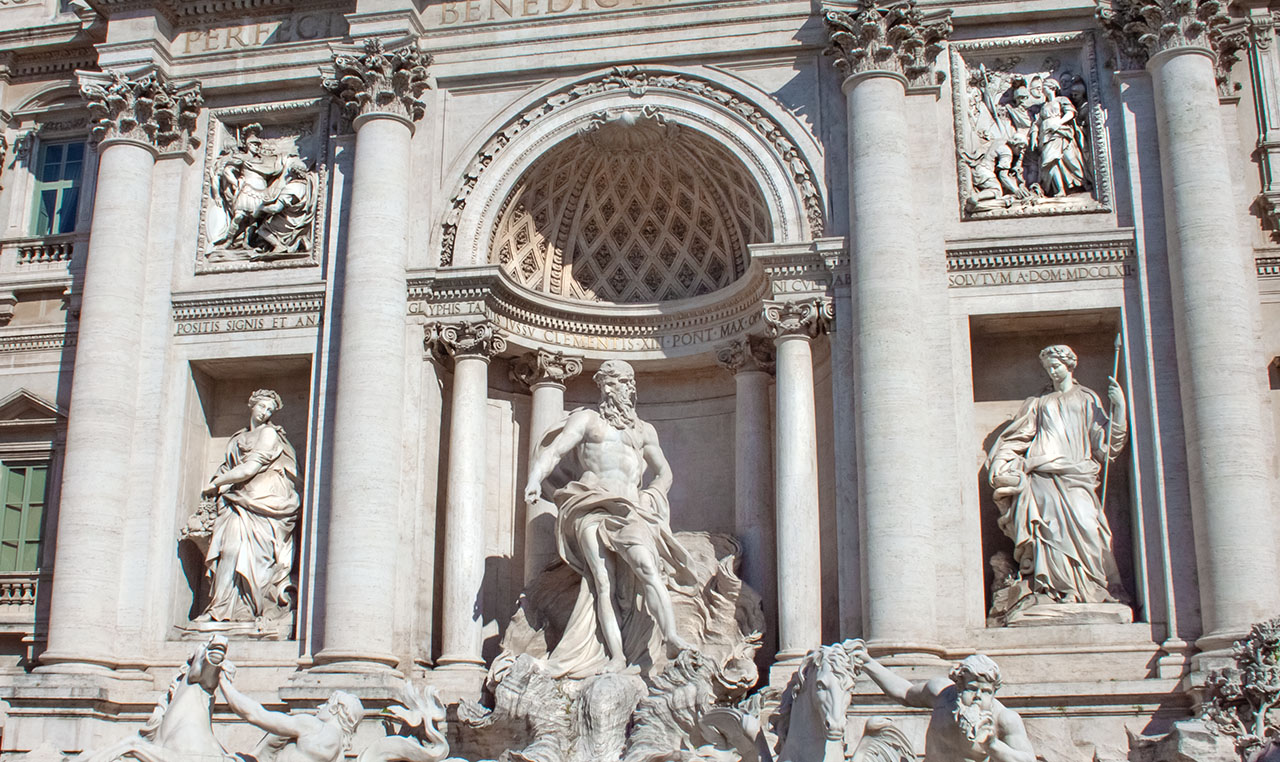
4. Pagan Tradition of Tossing a Coin into Trevi Fountain
Throughout history, the world over, the captivating ritual of tossing a coin into a fountain or well has echoed ancient pagan traditions—a timeless act of reverence to local deities and water spirits.
Ancient cultures and civilizations alike embraced this symbolic practice, a heartfelt offering to seek good fortune, blessings, or the fulfillment of heartfelt desires. The sacred fountains and wells were revered as channels of divine power and spiritual energy, and the act of making a wish held profound significance.
At the heart of the Trevi Fountain lies a similar enchanting tale—one that traces back to an ancient pagan ritual. An old practice of making offerings to the water gods, the act of throwing a coin into its shimmering waters carries a profound symbolism.
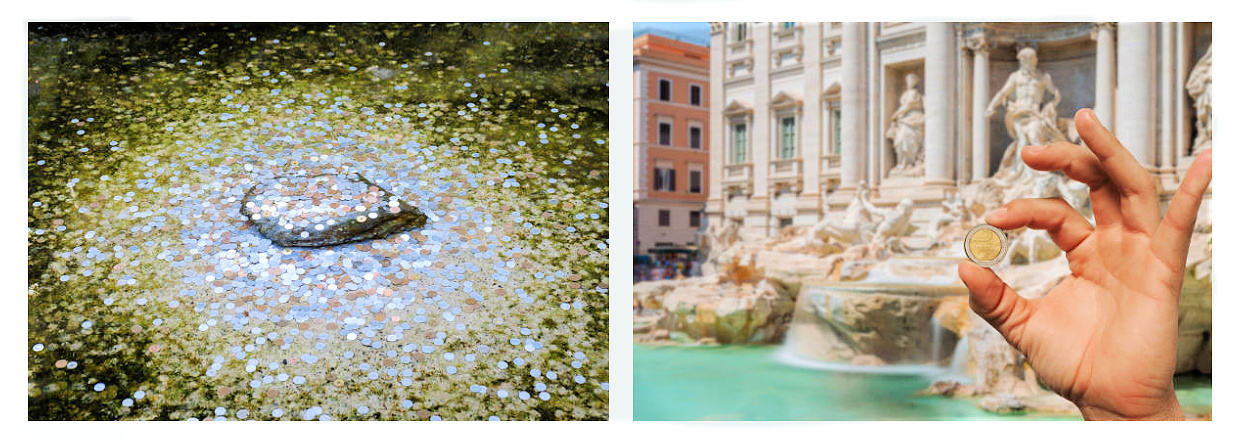
Each coin is a plea for blessings and protection from the divine entities that have watched over the waters for centuries. As visitors toss their coins with hope in their hearts, they become part of a timeless tradition, a delicate dance between the mortal and the divine.
This endearing tradition owes its fame to the inspiration of a notable figure—Wolfgang Helbig, a German archaeologist who graced the city of Rome during the 19th and 20th centuries. As a prominent member of German social circles, Helbig was deeply intrigued by the ancient customs he encountered. Drawn to the symbolism and allure of water rites, he wove these age-old practices into the very fabric of the Trevi Fountain's legacy.
Legend of Tossing a Coin into the Trevi Fountain
According to local lore, a more recent legend surrounds the act of tossing a coin into Trevi Fountain.
The first act, perhaps the most common, involves tossing a single coin over your left shoulder with your right hand. With this simple gesture, the belief is firmly held that a return to Rome is guaranteed. Whether bidding adieu to the city or yearning for a future reunion, this single coin embodies the essence of the Trevi Fountain tradition.
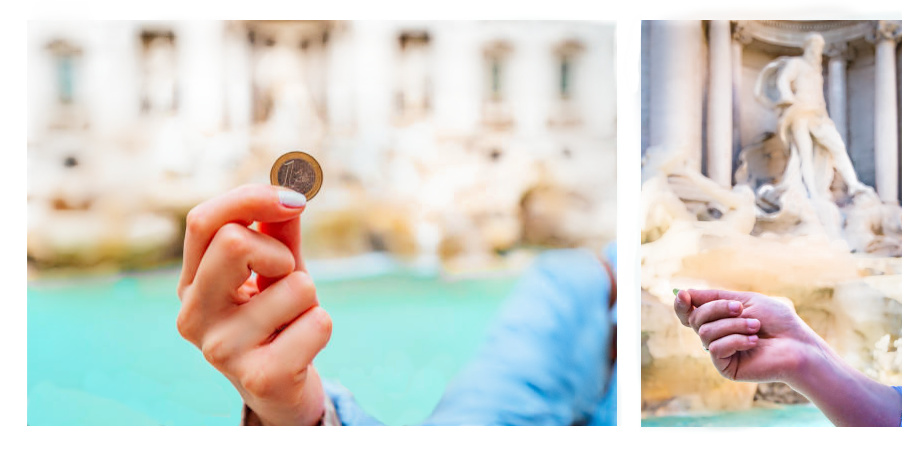
For the dreamers seeking love and romance, the second variation calls for the tossing of two coins into the fountain. As the coins cascade into its depths, the chance of finding true love in the near future is believed to increase, adding a touch of magic to the hearts of all romantics who venture to the fountain.
But it doesn't end there; the grand finale is reserved for the bold souls who toss three coins into the fountain. Three coins symbolize a triumphant trifecta of desires: a return to Rome, the discovery of love in the Eternal City, and the promise of marriage.
As the coins unite with the waters, hope and dreams intertwine in a dance of destiny, creating an unforgettable moment at the iconic Trevi Fountain.
How do you throw a coin into Trevi Fountain?
Stand at the edge with your back to the fountain, then toss a coin over your left shoulder using your right hand straight into the shimmery pool of the fountain.

Through the centuries, countless travelers have embraced this tradition, leaving behind a trail of dreams and desires in the fountain's waters. Each coin holds a unique story, a hope, a wish for the future. And as the coins rest at the fountain's bottom, they form a mosaic of dreams, connecting people from different cultures and backgrounds.
As you stand before the magnificent Trevi Fountain, allow yourself to be transported into a world of myths, legends, and timeless beauty. The fountain's intricate sculptures, cascading waters, and vibrant atmosphere are a testament to the rich history and enduring allure of Rome. Embrace the traditions of coin tossing, make your wishes, and immerse yourself in the captivating stories that have woven themselves into the fabric of Trevi Fountain.
5. Legend of the Ace of Cups
The Trevi Fountain conceals a fascinating secret known as the "Ace of Cups" - or Asso di Coppe in Italian, reminiscent of the local card game, Scopa.
"Scopa", an intriguing Italian game, introduces the "Asso di Coppe", the Ace of Cups, as one of its special cards. The objective of the game is to clear all the cards from the table, with players discarding the final card in an exhilarating winning moment.
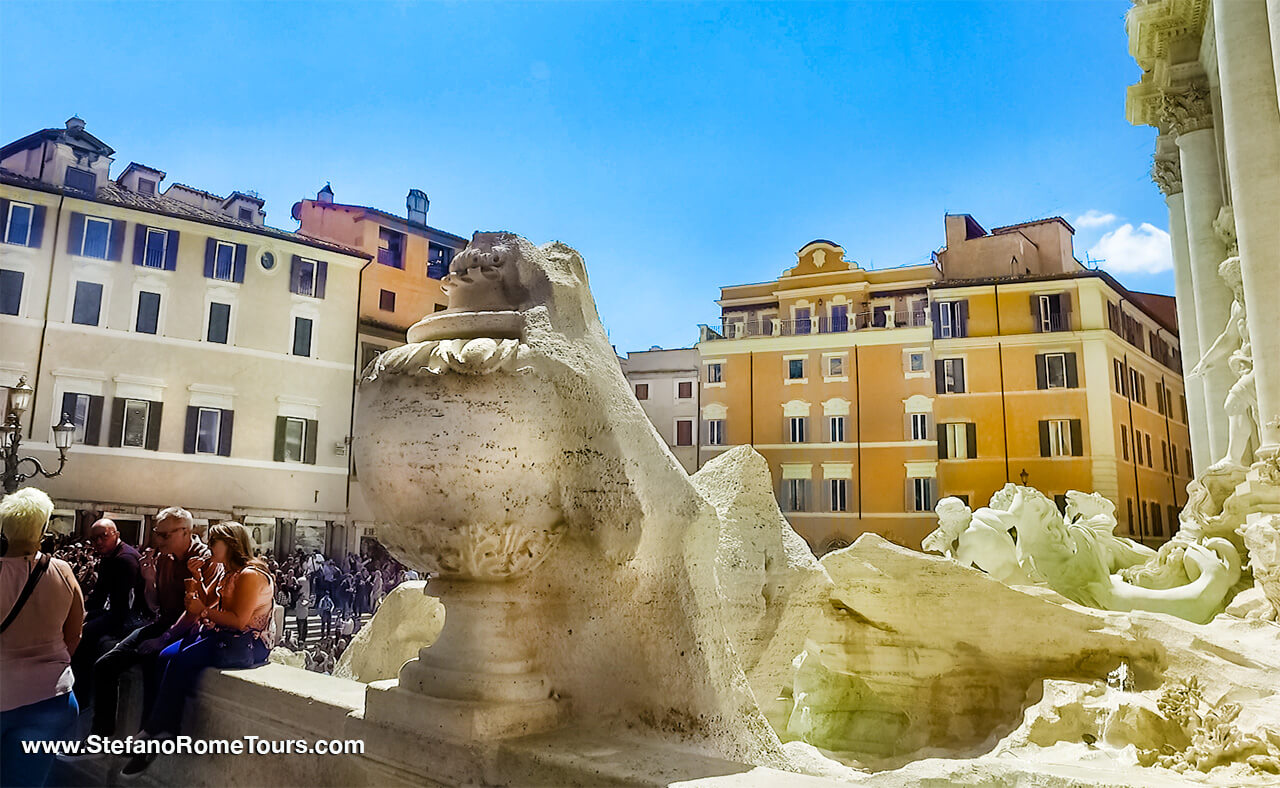
The toponym's origin lies in the vase's resemblance to the ace of cups depicted on playing cards. Carved from travertine, this remarkable vase leans against the fountain's external balustrade and goes unnoticed by most visitors (but after you read this blog, you will surely seek it out!).
A delightful legend also surrounds the vase's placement, one involving a determined barber with an opinion to share. As the Trevi Fountain's construction began, it inconvenienced a barber whose longstanding shop stood nearby. Perturbed, the barber may have lost customers or felt the sting of disruption due to ongoing construction works. Seizing each chance, he voiced criticisms of Nicola Salvi's design and found fault with various details.
Ingeniously, the architect devised a way to thwart the relentless barber. He strategically positioned the large travertine vase, the "Ace of Cups", to partially obstruct the barber's view hoping to deter further invectives, or better, yet, block the barber shop from view from folks standing before the fountain. The vessel, curiously reminiscent of the containers once used by barbers for their tools, stood as a silent barrier to the relentless critic.
Whether rooted in truth or spun from legend, the tale of the "Ace of Cups" serves as a poignant reminder that even the grandest monuments of Rome possess hidden stories waiting to be unveiled. These obscure nuances add an alluring layer of mystery to the city's majestic heritage, waiting to be discovered by those with a keen eye for history's charming secrets.
ALSO READ:
- 10 Best Reasons to Visit Rome in the Spring
- Best Souvenirs to Bring Home from Rome: Original and Authentic Ideas
- The Best Way to Get Around Rome
The Trevi Fountain stands not only as a splendid work of art but as a living repository of stories that echo through the ages. So, the next time you stand before its grandeur, take a moment to absorb not just the visual magnificence but the magical tales that have enchanted generations.
In doing so, you will find that your visit to the Trevi Fountain becomes not just a sightseeing experience, but a journey into the captivating myths and legends that have shaped its enduring allure.
We invite you to browse through our private tours of Rome, Rome Shore Excursions from Civitavecchia, Civitavecchia Post Cruise Tours, and Rome pre-cruise tours and select your postcard-perfect Rome tour for a taste of La Dolce Vita on your next trip to Italy!
